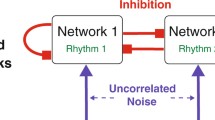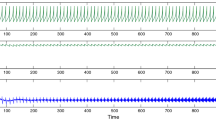Abstract
Coupled excitable elements in the presence of noise can exhibit oscillatory behavior with non-trivial frequency dependence as the coupling strength of the system increases. The phenomenon of frequency enhancement (FE) occurs in some coupling regime, in which the elements can oscillate with a frequency higher than their uncoupled frequencies. In this paper, details of the FE are investigated by simulations of the FitzHugh-Nagumo model with different network topologies. It is found that the characteristics of FE, such as the maximal enhancement coupling, enhancement level etc, are functions of the network topology and spatial dimensions. The effect of excitability and the spatio-temporal patterns during FE are investigated to provide an intuitive picture for the enhancement mechanism. Interestingly, some of these characteristics of FE can be described by scaling laws; suggesting the existence of universality in the FE phenomenon. The relevance of these results to biological rhythms are also discussed.
Similar content being viewed by others
References
L. Gammaitoni, P. Hanggi, P. Jung, F. Marchesoni, Rev. Mod. Phys. 70, 223 (1998)
A.S. Pikovsky, J. Kürths, Phys. Rev. Lett. 78, 775 (1997)
Z. Liu, Y.-C. Lai, A. Nachman, Phys. Lett. A 297, 75 (2002)
Z. Liu, Y.-C. Lai, A. Nachman, Int. J. Bifurc. Chaos 14, 1655 (2004)
Y.-C. Lai, Z. Liu, A. Nachman, L. Zhu, Int. J. Bifurc. Chaos 14, 3519 (2004)
Y. Kuramoto, Chemical Oscillations, Waves and Turbulence (Springer-Verlag, Berlin, 1984)
R.E. Mirollo, S.H. Strogatz, SIAM J. Appl. Math. 50, 1645 (1990)
H. Daido, S. Matsumoto, Europhys. Lett. 64, 613 (2003)
W.Y. Chiang, P.Y. Lai, C.K. Chan, Phys. Rev. Lett. 106, 254102 (2011)
J.A. Mohawk, J.S. Takahashi, Trends Neurosci. 34, 349 (2011)
W. Chen et al., Europhys. Lett. 86, 18001 (2009)
R. FitzHugh, Biophys. J. 1, 445 (1961)
J. Nagumo, S. Arimoto, S. Yoshizawa, Proc. IRE. 50, 2061 (1962)
A. Hodgkin, A. Huxley, J. Physiol. 117 500 (1952)
H. Risken et al., The Fokker-Planck Equation (Springer, Berlin, 1989)
C. Zhou, J. Kürths, B. Hu, Phys. Rev. Lett. 87, 098101 (2001)
C. Zhou, J. Kürths, B. Hu, Phys. Rev. E 67, 030101(R) (2003)
P. Erdös, A. Renyi, Publicationes Mathematicae 6, 290 (1959)
A.-L. Barabasi, R. Albert, Rev. Mod. Phys. 74, 47 (2000)
A. Pikovsky, M. Rosenblum, J. Kurths, Synchronization: A Universal Concept in Nonlinear Sciences (Cambrige university press, Cambrige, 2003)
A.T. Winfree, The Geometry of Biological Time, 2nd edn. (Springer-Verlag, 2001)
M.R. Boyett, H. Honjo, I. Kodama, Cardiovescular Res. 47, 658 (2000)
R.Y. Moore, J.C. Speh, R.K. Leak, Cell Tissue Res. 309, 89 (2002)
L.C. Jia, M. Sano, P.-Y. Lai, C.K. Chan, Phys. Rev. Lett. 93, 088101 (2004)
P.-Y. Lai, L.C. Jia, C.K. Chan, Phys. Rev. E 73, 051906 (2006)
A. Kamkin, I. Kiseleva, I. Lozinsky, H. Scholz, Basic Res. Cardiol. 100, 337 (2005)
D.M. Cai, R.L. Winslow, D. Noble, IEEE Trans. Biomed. Eng. 41, 217 (1994)
S. Yamaguchi et al., Science 302, 1408 (2003)
Y. Yamauchi et al., Biol. Cybernetics 86, 147 (2002)
T. Hachiro et al., BioSys. 90, 707 (2007)
M. Oyamada et al., Exp. Cell Res. 212, 351 (1994)
K. Kawahara et al., Biol. Rhythm Res. 33, 339 (2002)
W.Y. Chiang, P.Y. Lai, unpublished
B. Blasius, E. Montrio, J. Kurths, Phys. Rev. E 67, 035204(R) (2003)
J.P. Fahrenbach et al., J. Physiol. 583, 565 (2007)
Author information
Authors and Affiliations
Corresponding author
Rights and permissions
About this article
Cite this article
Chiang, WY., Lai, PY. & Chan, CK. Frequency enhancement in coupled noisy excitable elements: effects of network topology. Eur. Phys. J. B 86, 327 (2013). https://doi.org/10.1140/epjb/e2013-40422-7
Received:
Revised:
Published:
DOI: https://doi.org/10.1140/epjb/e2013-40422-7




